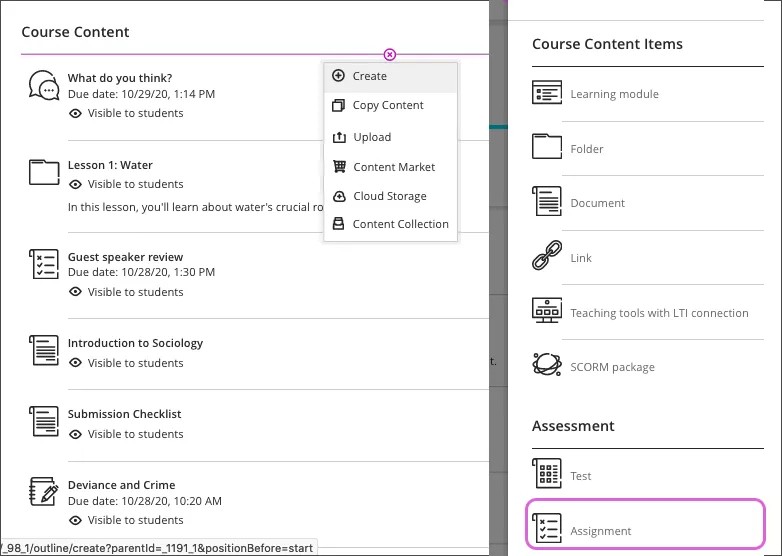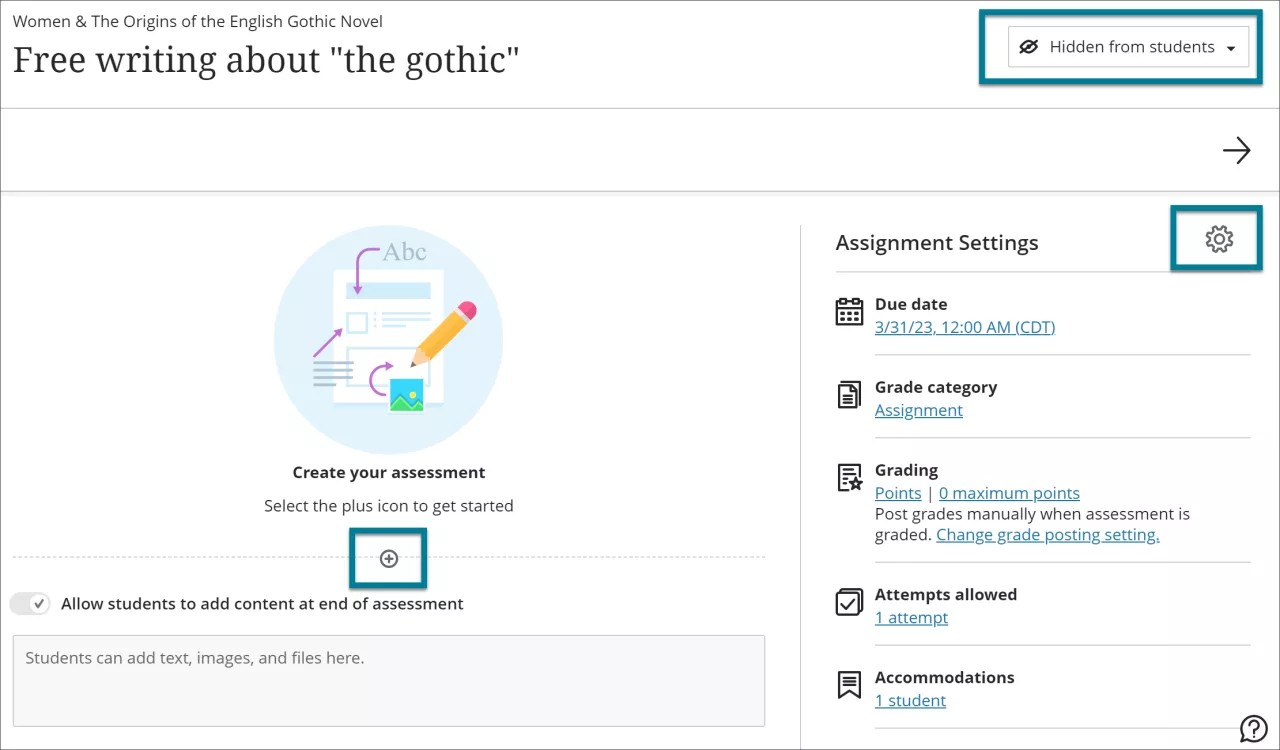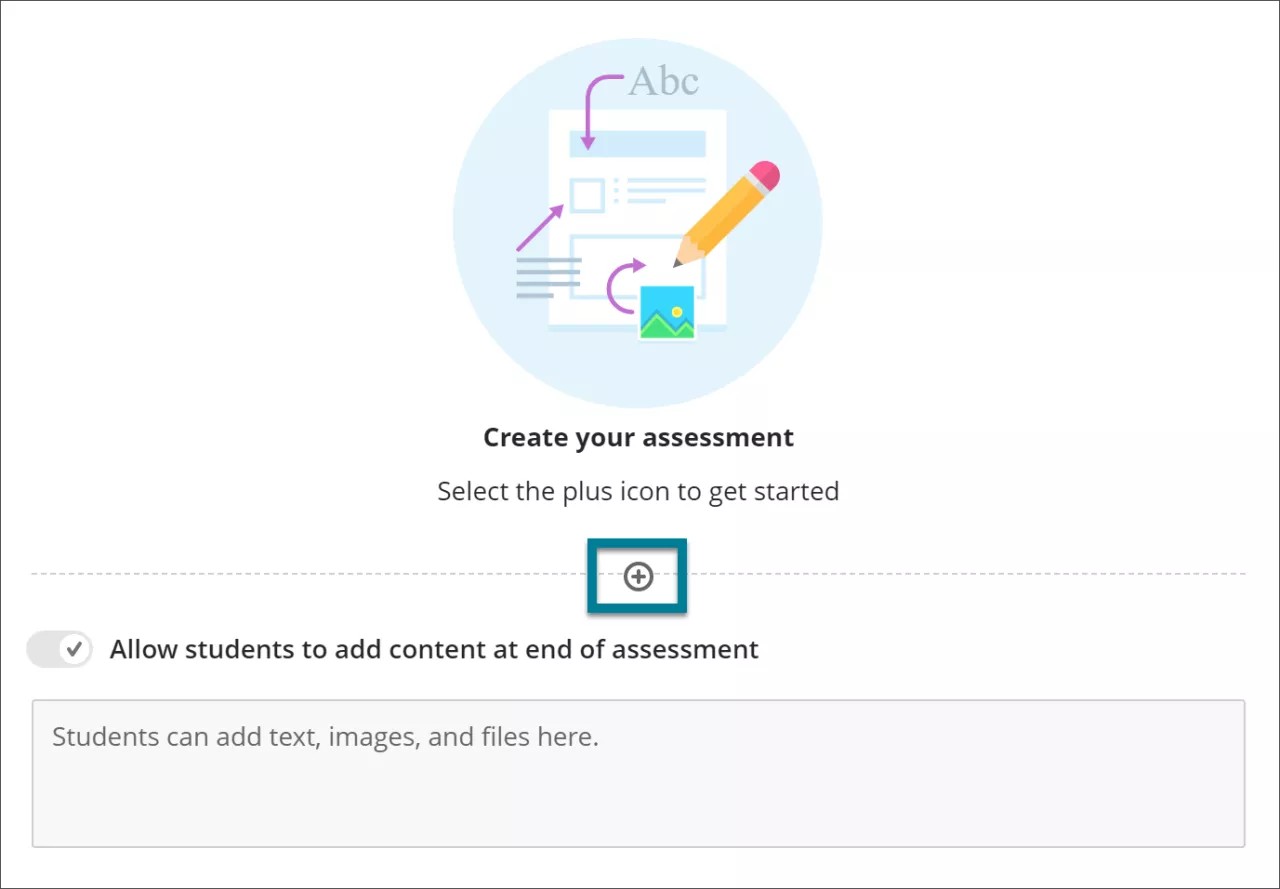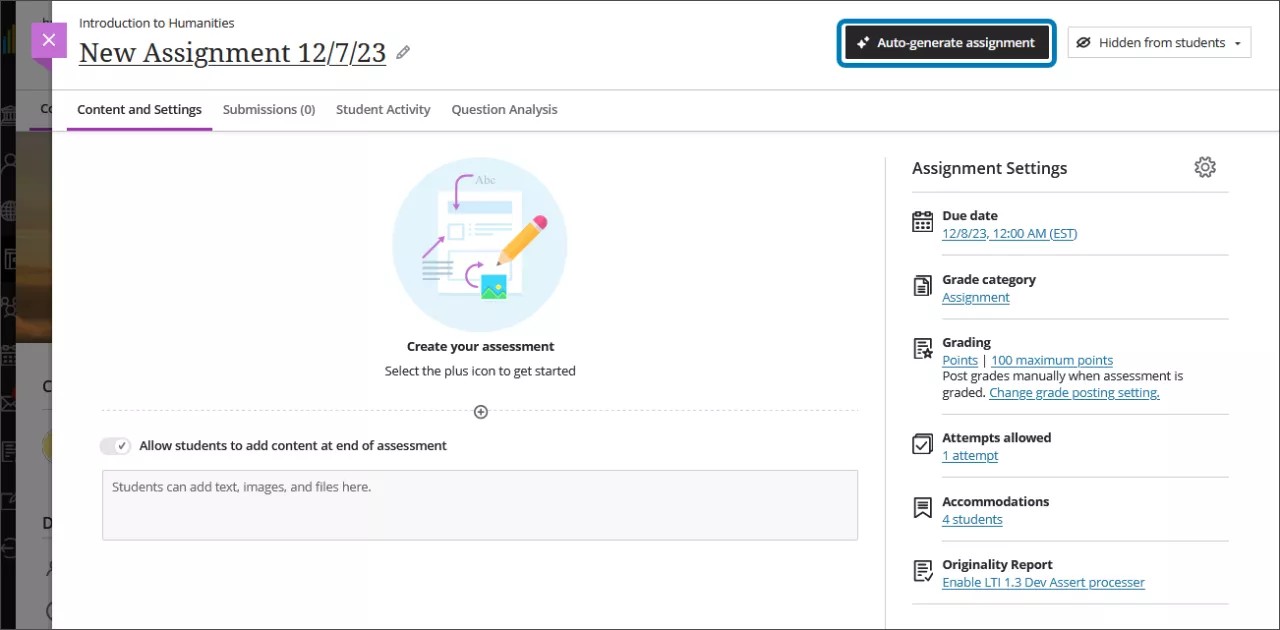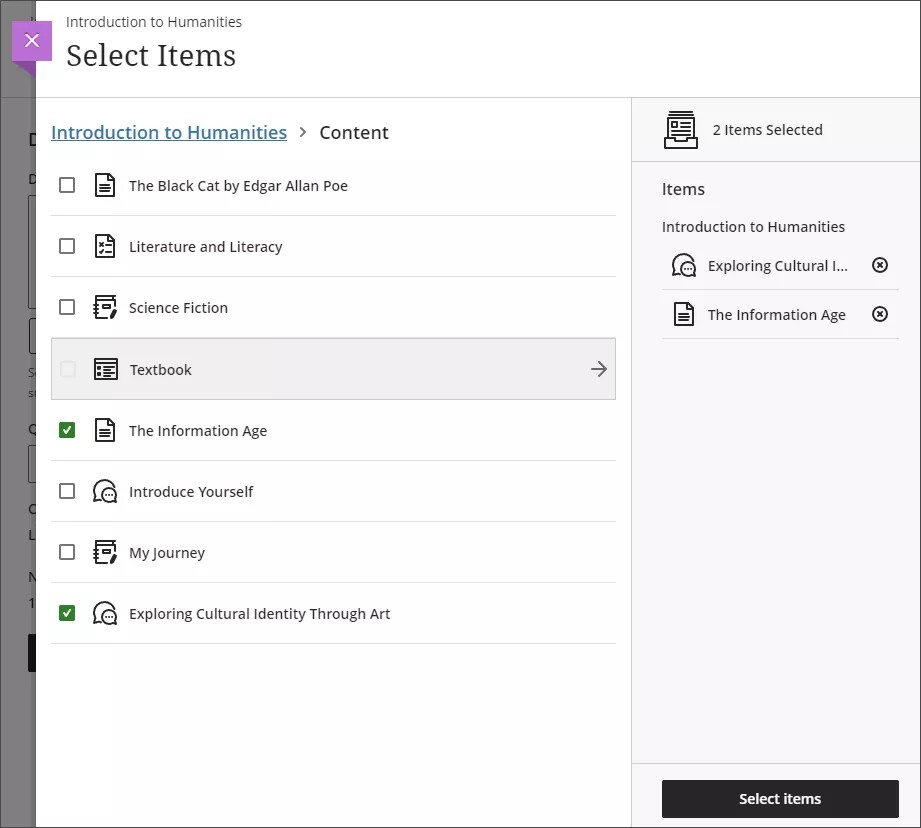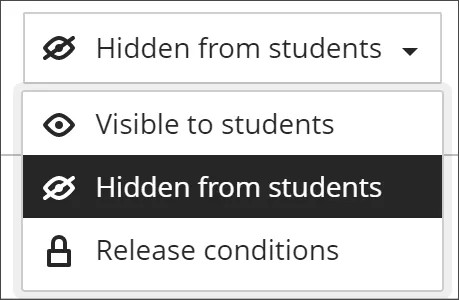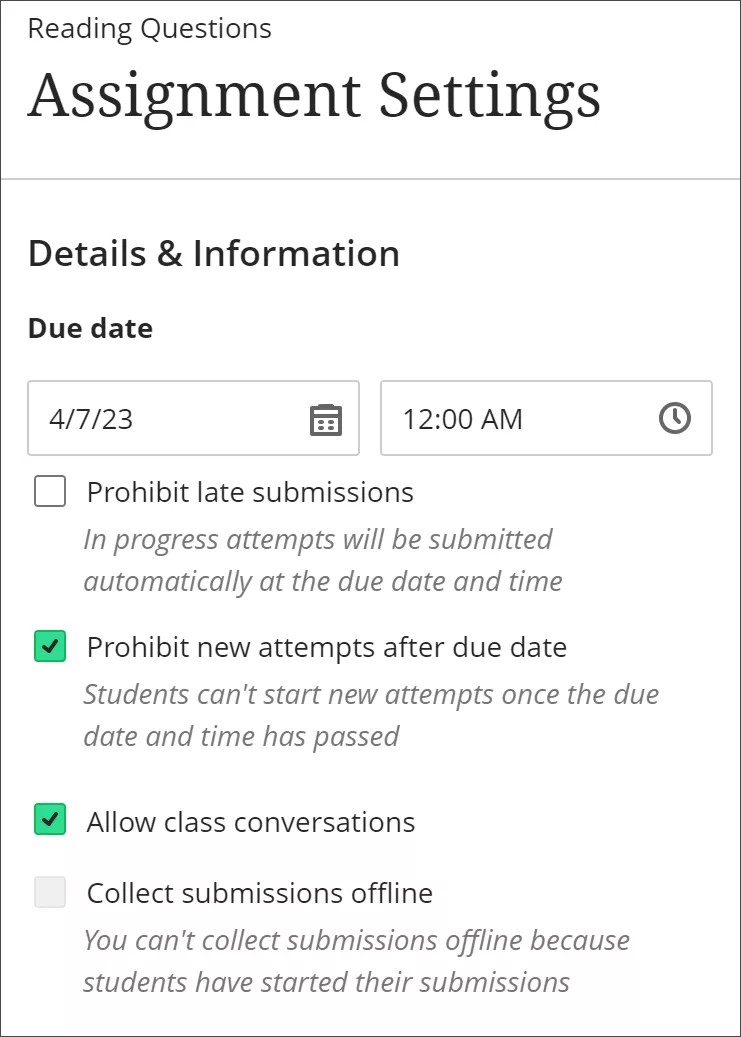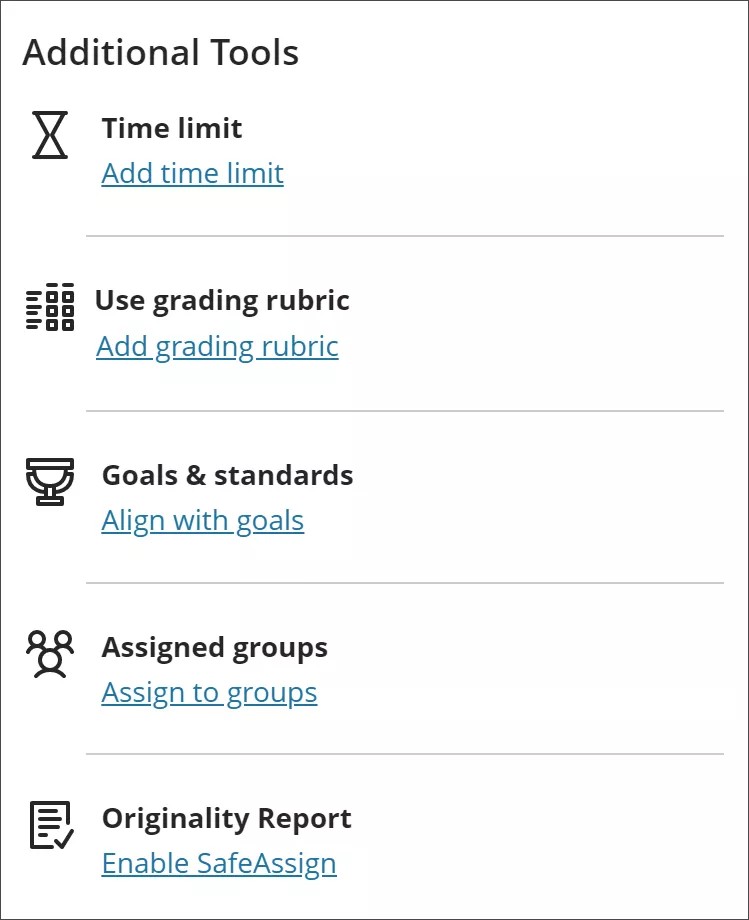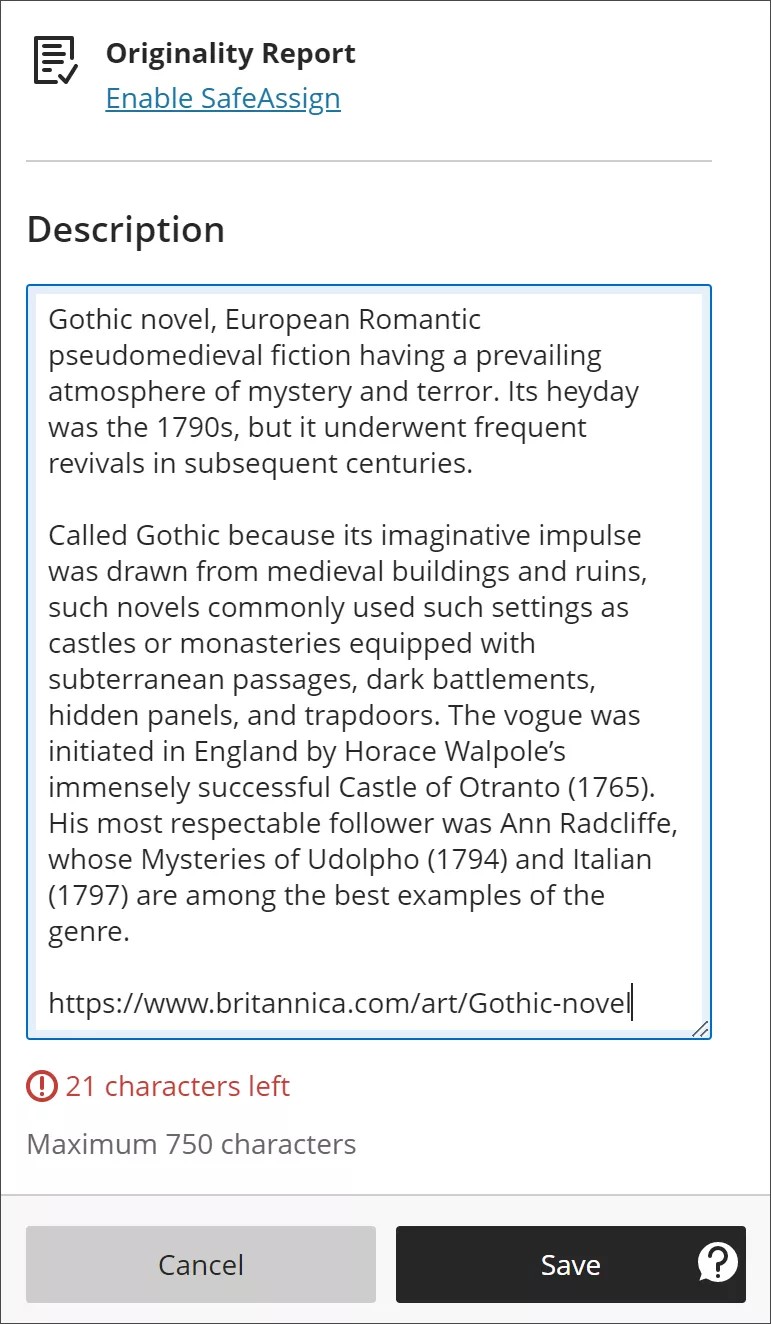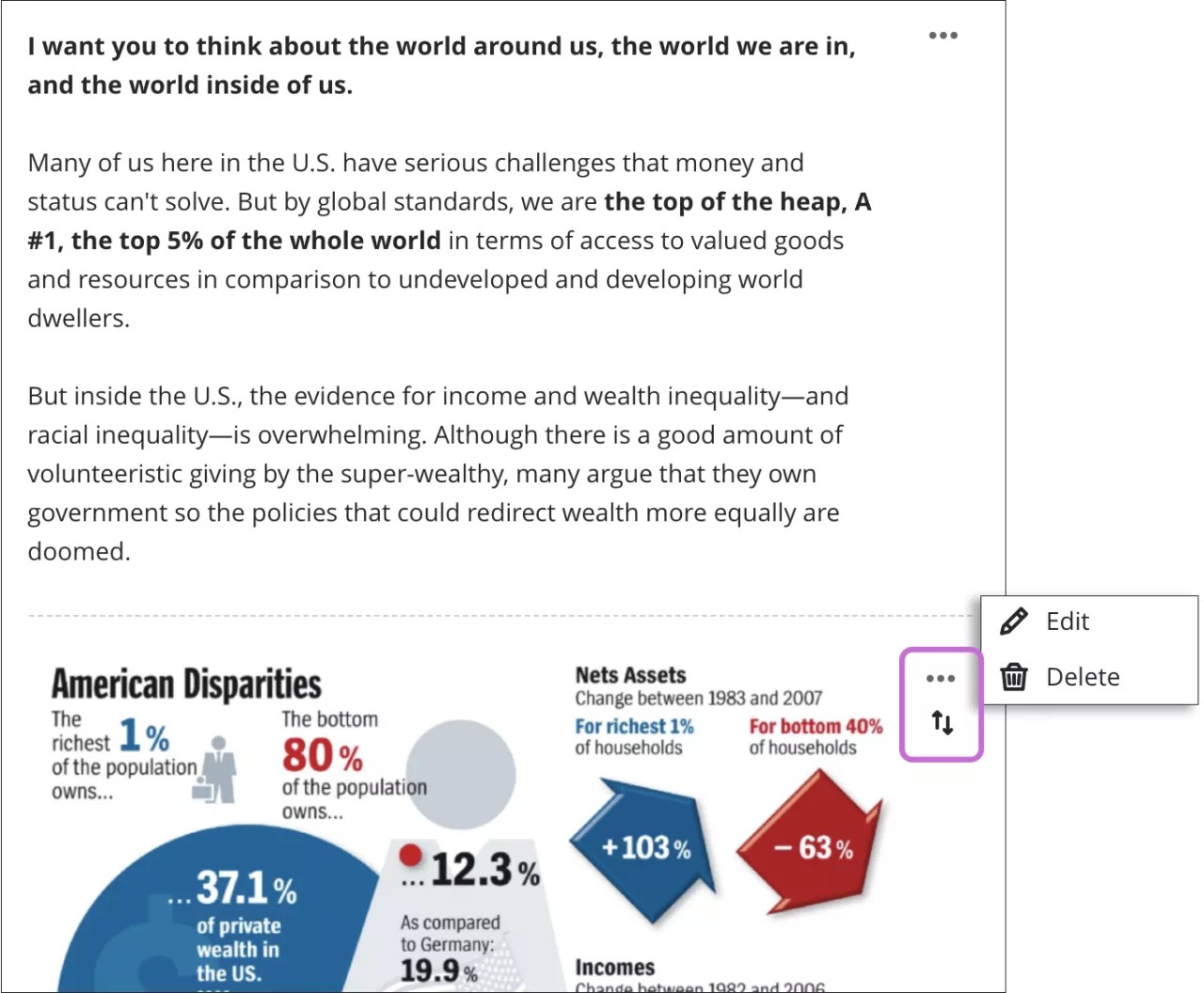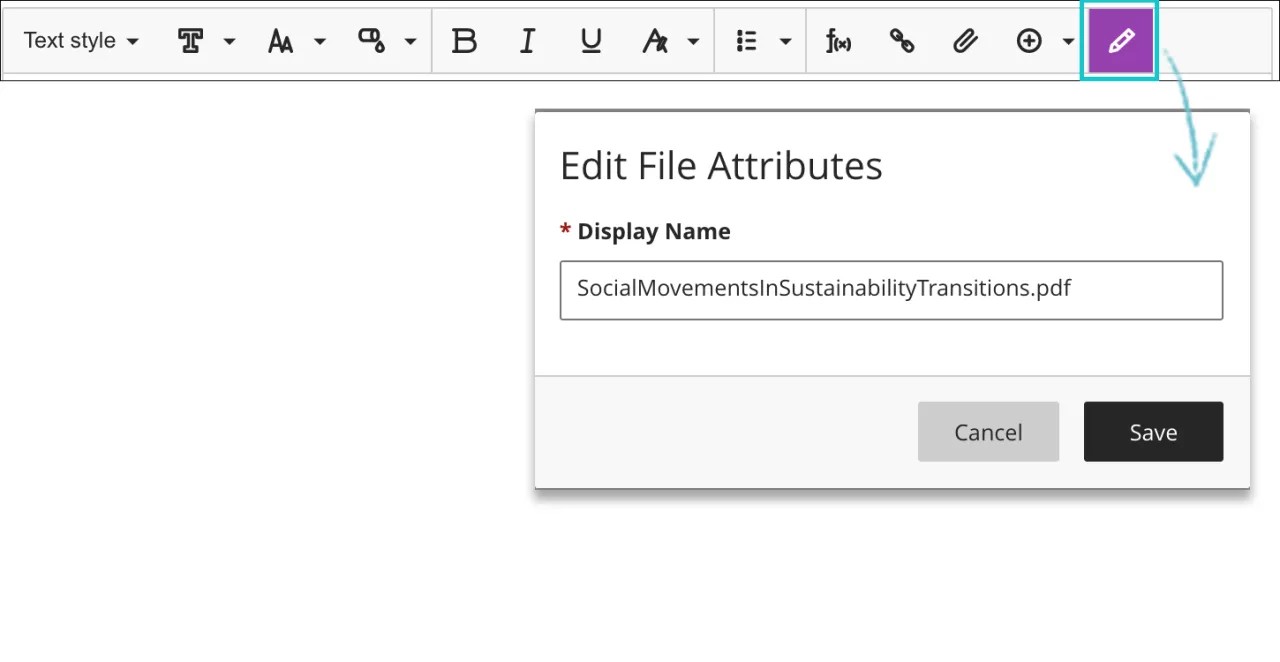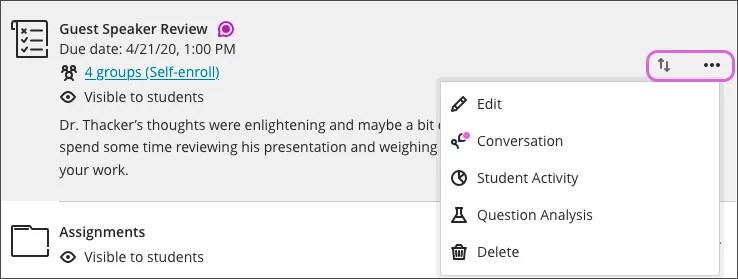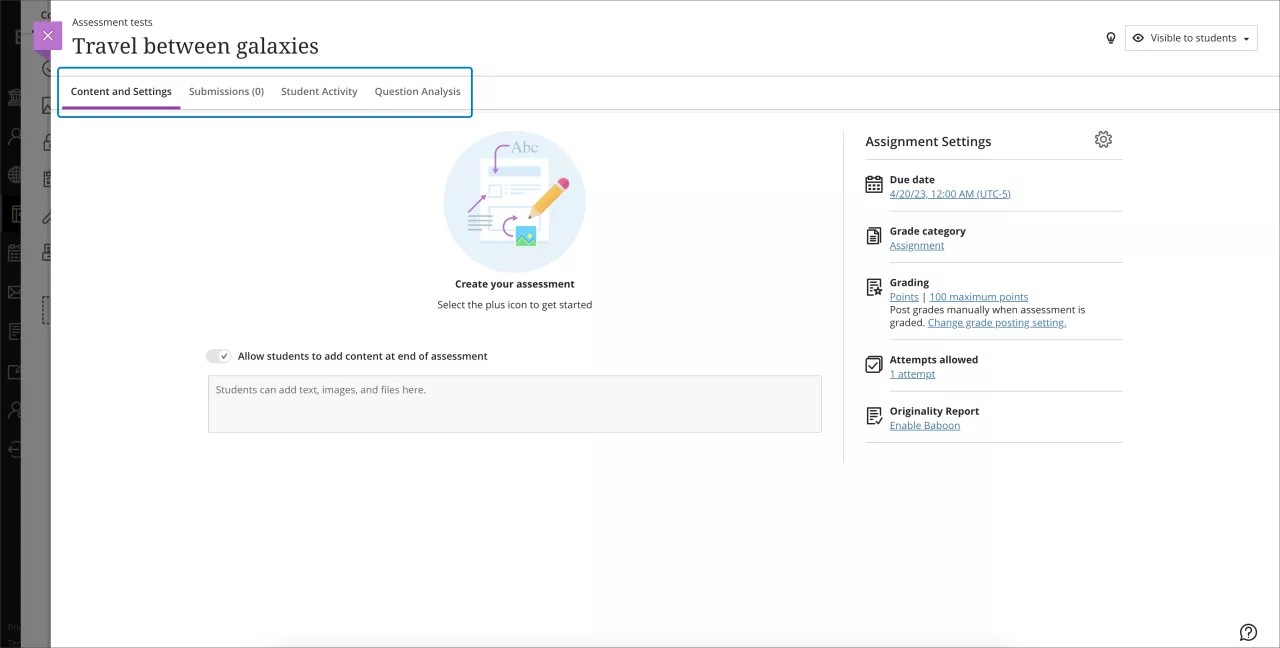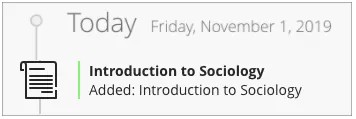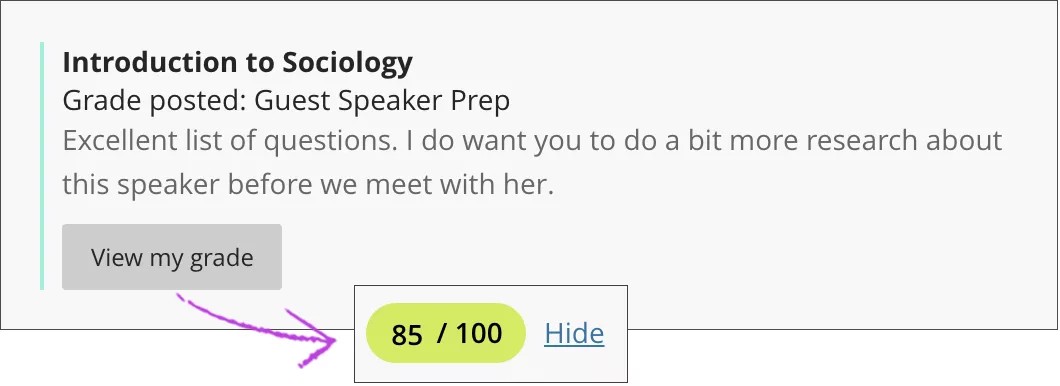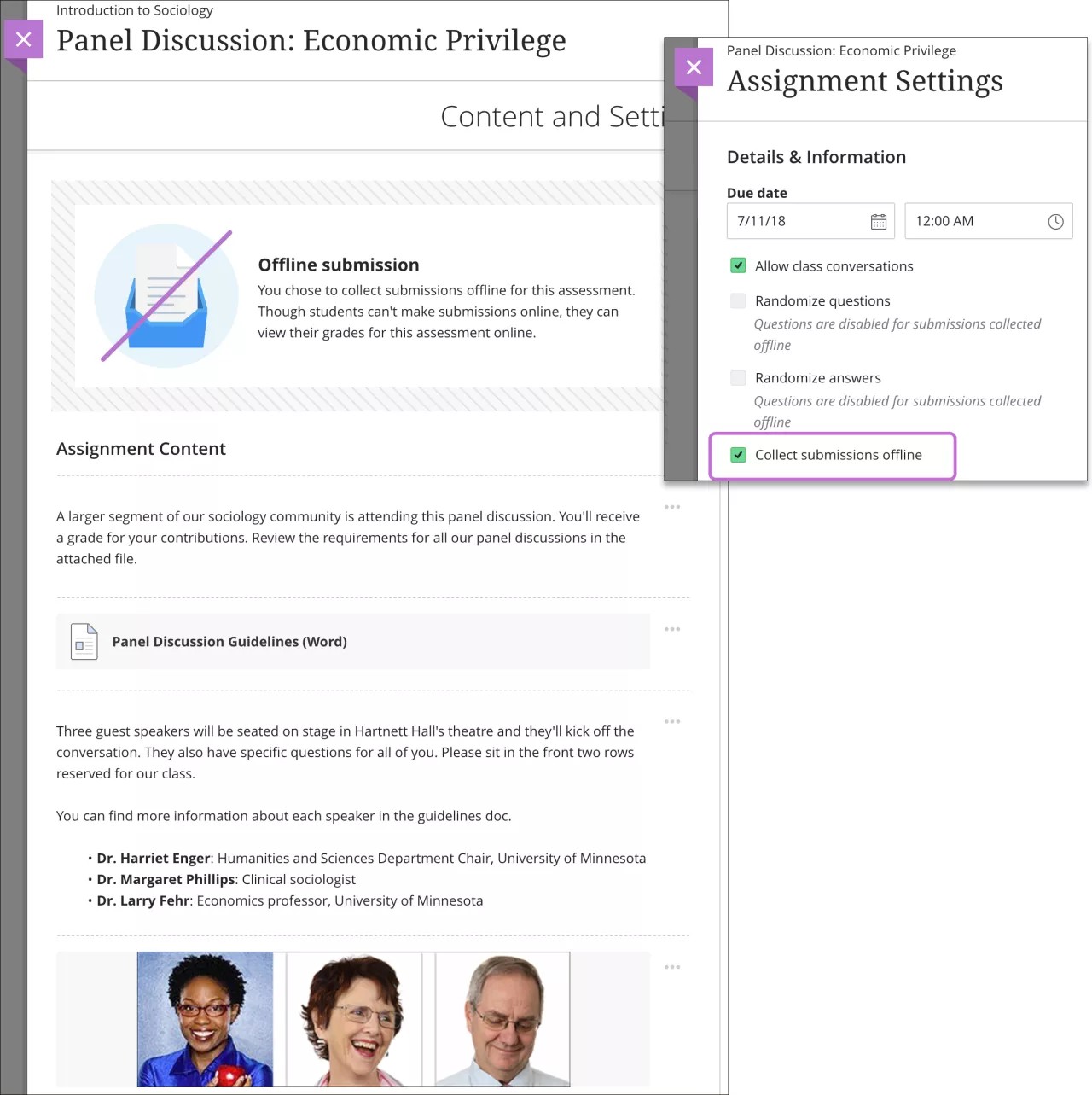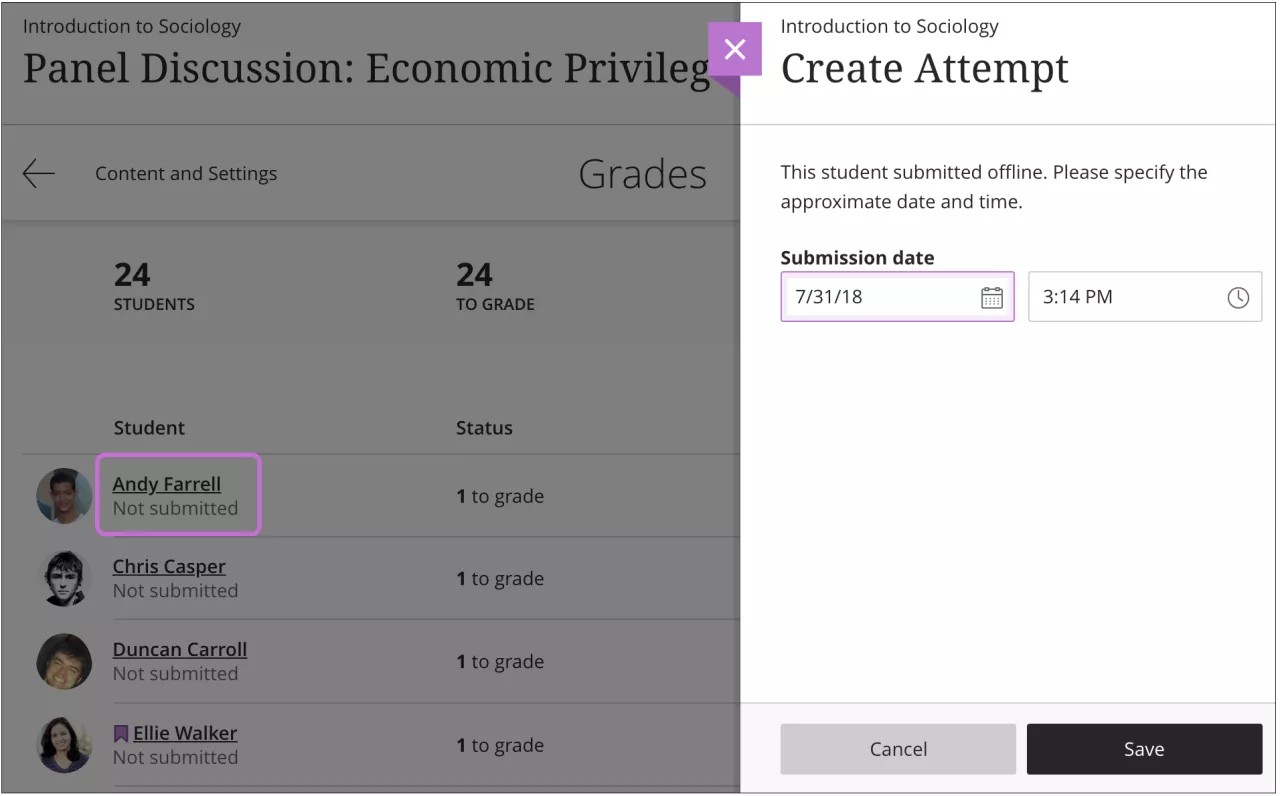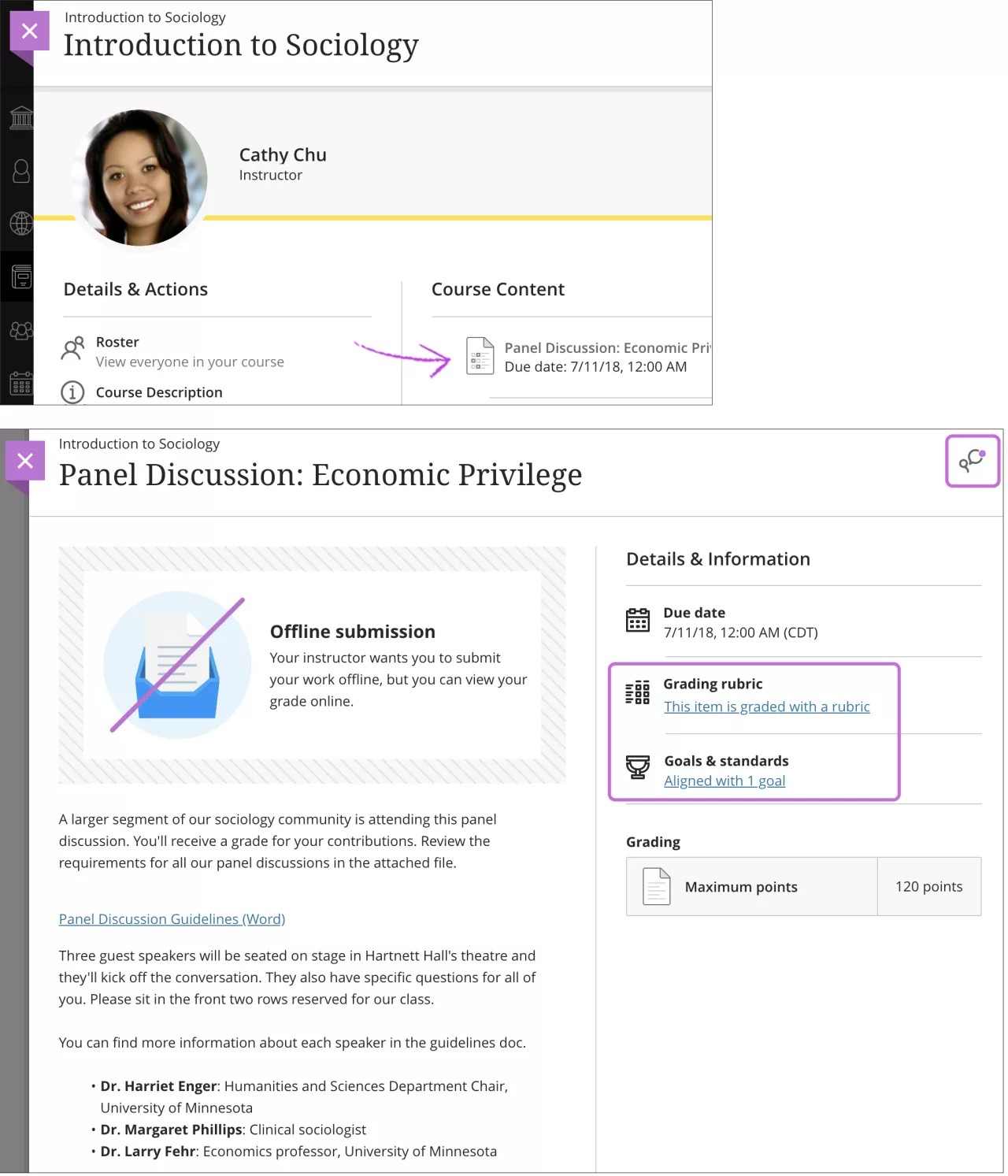This information applies only to the Ultra Course View.
This information applies only to the Ultra experience.
Your institution controls which tools are available in the Original Course View. Assignments are always available to instructors in the Ultra Course View.
Create an assignment
Assignments are always available to instructors in the Ultra Course View.
You can create assignments alongside other content. Students can access their work next to the content they need, right when they need it. You can also create a group assignment and release it to one or more groups in your course.
More on creating assignments for groups of students
Feel free to experiment! Students can't see what you add until you make your assignments visible.
On the Course Content page, select the plus sign wherever you want to add an assignment. In the menu, select Create to open the Create Item panel and select Assignment. The New Assignment page opens.
You can also expand or create a folder and add an assignment.
When you create an assignment, a gradebook item is created automatically.
After you post assignment grades, students can view their scores on their grades pages or in the activity stream. They can also access an assignment, their submissions, your feedback, rubrics, and their grades from the assignment link on the Course Content page.
Other topics on this page include:
Watch a video about creating assignments
The following narrated video provides a visual and auditory representation of some of the information included on this page. For a detailed description of what is portrayed in the video, open the video on YouTube, navigate to More actions, and select Open transcript.
Video: Create an assignment shows how to create an assignment with simplified workflows.
New Assignment page settings
Distinguishing Assignments and Tests in Ultra
Assignments and Tests (grouped under Assessments in the Course Content Items panel) share the same user interface and options. Many options in the settings are enabled or disabled based on whether at least one question is included in the assessment.
In practice, instructors use these assessments differently. For example, you might create an assignment with instructions for students to submit a file for a grade. In a test, students may answer a series of questions you’ve added to the assessment.
To distinguish between assignments and tests, and to highlight workflows with and without questions, the discussion of assignments will emphasize a workflow without added questions. You may easily add questions to your assignment if you choose.
For a description of a workflow that includes questions, go to Create Tests.
The New Assignment page
There are three customizable components on the new assignment page:
- add assignment content
- control assignment visibility to students
- apply assignment settings
Provide a descriptive title so students can easily find the assignment among your course content. On the Course Content page, the title appears as the link students select to view the materials. If you don't add a title, "New Assignment" and the date appear in the content list. If you don't add content, the assignment won't appear on the Course Content page.
Adding Assignment Content
Select the plus sign to open the menu to add text, files, and questions.
You can add files and text, such as instructions, to the assignment. You can also add files from cloud storage, such as OneDrive® and Google Drive™. These options are found towards the bottom of the add assignment content menu.
For information on adding questions, go to Create Tests.
Auto-generate assignments
AI plagiarism is a growing concern in education. Research indicates a variety of issues with a reliance on AI detection. Detection models cannot keep up with advancements in AI technologies. Learn empowers you to take advantage of the effective practice of authentic assessment. If your institution has turned on the AI Design Assistant feature, you can auto-generate assignment prompts that encourage students to:
- engage in higher-order thinking
- apply knowledge gained from your class
- produce authentic submissions that are evidenced
- emulate real-world situations
Assignment prompts are generated based on course context. On the assignment creation page, select Auto-generate assignment.
You’re brought to the Auto-Generate Assignment page.
The AI Design Assistant generates three assignment prompts. You have several ways to define the prompts that the AI Design Assistant generates.
- Enter a description (limited to 2000 characters) to narrow the focus of the prompts
- Select the desired cognitive level
- Apply
- Analyze
- Evaluate
- Create
- Inspire me! provides you with a mix of levels
- Adjust the complexity of the prompts’ focus by moving the slider
- Select whether or not you want to generate a title for the prompts
Cognitive levels are based on Bloom’s Taxonomy.
Optionally, you can select which course items you’d like the AI Design Assistant to provide context for the assignment prompts. Select Select course items to start.
Select the box beside any course content item to include it in the context for your test.
You can select the arrow beside a folder or learning module to include items from them. When you’ve finished choosing items for context, select Select items to return to question generation.
File types supported by the context picker include PDF, Word, PowerPoint, text, RTF, and HTML.
Once you’ve finalized your settings, select Generate. Review each prompt for accuracy and bias. Choose the prompt you’d like to add to your assignment, then select Add.
View the "AI Design Assistant" topic to learn more about the AI Design Assistant.
Assignment Visibility
Students can't see an assignment until you choose to show it. You can create all your content ahead of time and choose what you want students to see based on your schedule. You can also set availability conditions based on date, time, and performance on other items in the course gradebook. On the Course Content page, students can see when you set the assignment to appear.
Assignment Settings
The right-hand side of the page outlines Assignment Settings. To choose and apply settings, select the Settings button to open a new panel.
View accommodations. If any students in your course have accommodations, this will appear in the Assignment Settings section. You can set accommodations for students and make them exempt from certain course requirements, such as assignment due dates and time limits. To modify accommodations, go to the Roster and open a student's menu. You can also access it from the Submission page or Gradebook.
After choosing your settings, select Save at the bottom of the panel.
Details & Information
The section Details & Information provides options for assignment submission.
Provide a due date. Due dates appear on the calendar and in the activity stream. Late submissions appear with a Late label in the course gradebook. You can prohibit students from submitting work after the due date. Encourage students to review what’s due now and what’s ahead so they can ask questions as soon as possible.
Prohibit late submissions. Enforce a hard deadline and prevent a late submission. In-progress and saved attempts will auto-submit at the due date. Students will receive a submission receipt email. Specified accommodations are still honored.
If students have submitted attempts, you cannot change the due date to a date in the past. If the due date has passed, you can't select the Prohibit late submission setting.
Prohibit new attempts after due date. Prevent students from beginning a new attempt after the due date. Specified accommodations are still honored.
Allow class conversations. What if your students have questions about an assignment? You can allow conversations within an assignment, and anyone can contribute. As the conversation develops, it appears only with the relevant assignment.
Collect submissions offline. You may want to grade student work that doesn’t require students to upload a submission. For example, you can add grades to your gradebook for oral presentations, science fair projects, acting performances, and artwork delivered in person.
More on collecting submissions offline
Formative assessments. Their primary purpose is to monitor student learning and provide immediate feedback that can be used to improve instruction and enhance student performance. Formative assessments help both you and your students to identify areas of strength and areas that need further development.
Presentation Options
If your assignment contains questions, Presentation Options allows you to control how the assignment's content is presented to students.
For more details about options in Presentation Options, go to Create Tests.
Grading & Submissions
Grading & Submissions provides options for assignment type and grading criteria.
Change the grade category. You can change the assignment's grade category to be part of one of the custom gradebook categories you set up in your course. You can create new categories to customize how coursework is grouped in your course. Custom categories can be useful when you set up the overall grade.
Determine the number of attempts. You can let your students submit more than one attempt at an assignment. When you allow multiple attempts, you can also choose how the final grade is calculated.
Select the grading schema. From the Grade using menu, select an existing grading schema such as Points. You can change the grading schema at any time, and the change will appear to students and in your gradebook.
Set Maximum points. Add a number value between 0 and 99,999 for your assignment. If you leave this field blank, the number will default to 100.
Enable anonymous grading. When you create an assignment without questions, you can enable anonymous grading. Student names are hidden while you grade. You may only add text and files to anonymously graded assignments.
Enable parallel grading. Parallel grading assigns two graders per student. You can enable parallel grading and assign graders when you create an assignment. You can also enable parallel grading after students make submissions. The system randomly assigns graders you choose so each student has two graders for the assignment. The grading workload is distributed evenly among the graders. Graders can only open the submissions of the students assigned to them. Instructors or reconcilers determine the final grades for students.
Enable peer review. Peer review allows students to review their peers’ work through criteria-based evaluation. Select Select peer settings to assign the number of reviews per student, assessment due date, and peer review due date.
Parallel grading and peer review options are disabled for an assessment with questions. Parallel grading and peer review can't be enabled at the same time.
Enable assessment grade. Automatically post a student’s grade once grading is completed. Turn the setting off if you want to manually control grade publication.
Assessment results
If your assignment contains questions, Assessment results allows you to control how students see feedback, scores, and answers once they turn in their work.
For more details about options in Assessment results, go to this section in Create Tests.
Assessment security
Assessment security provides tools to secure assignments you create.
Add an access code. You can issue an access code to control when students submit an assignment. Access codes are generated randomly by the system. You can also add an access code to a group assignment.
Access Respondus. Respondus® is a third-party tool you can use to create, manage, and print tests in Blackboard. Select the link to launch the tool.
Additional Tools
Additional Tools provides several more options to customize your assignment.
Add a time limit. A time limit can keep students on track and focused on the assignment. Each student has a limited amount of time to submit. The assignment attempts are saved and submitted automatically when time is up. You can also allow students to work past the time limit. Time limits can only be added to individual (not group) assignments.
Add a grading rubric. A rubric is a scoring tool to evaluate graded work. Rubrics can help you evaluate student submissions based on key criteria that you define. You can create a new rubric or associate an existing rubric. You can only add a rubric to as assignment without questions.
Add goals and standards. You can align an assignment to one or multiple goals. You and your institution can use goals to measure student achievement across programs and curricula. You can also align individual questions to goals.
Make a group assignment. You can create an assignment for one or more groups of students. By default, you assign a grade to each group as a whole, but you can change a group member's individual grade.
Enable SafeAssign. You can use SafeAssign to check for potential plagiarism in student submissions. You can enable the SafeAssign Originality Report any time, even after students have started their submissions. However, submissions are only checked when SafeAssign is enabled.
Add an optional description. The description appears with the assignment title on the Course Content page. This is where you can provide students with more information about the assignment. The maximum length of a description is 750 characters. A warning will appear below the description field when 75 characters or less remain.
If you go over the maximum length, a warning will indicate how many characters over the limit you are. You will not be able to save the description until your text is below the maximum length.
Add files and text blocks to assignments
Select the plus sign to open the menu wherever you want to add questions, text, or a file. You can add as many text blocks and files as you want.
Add text blocks. Select Add text to open the editor. You can include instructions for a section of the assignment or introductory text for an audio file or image. You can also paste text from a Word doc.
You can also use the editor to embed images and attach files along with your text.
If you create an assignment that includes only text blocks, you can manually change the Maximum score in the Assignment Settings.
Add files. Select Add local file to browse for a file on your computer. Your institution controls the maximum file size you can upload. You can't add a folder of files.
Add file from Cloud Storage: You can instantly connect to multiple web apps where you store files, such as OneDrive. The files you add are copies. If you make a change to a file in cloud storage, you need to upload a new copy in your course. If your browser allows, media files you add from cloud storage display inline.
Media file viewing options
Media file viewing options
If your browser allows, media files you add to assessments display inline by default. If your browser can't display a media file inline, it appears as an attachment. Files you add from cloud storage behave in the same way.
Images that display inline are embedded in a 768-pixel block at the biggest breakpoints. The closer to that size the images are, the less padding appears around them.
Access a media file's menu and select Edit.
To edit the file's alternative text or display behavior, select the file in the editor and then select the Edit Attachment icon.
In the Edit File Attributes window, you can choose how your video, audio, or image file appears in the assessment: inline or as an attachment. For example, you can display extremely large files as attachments that students can download. You can edit the file names for files displayed as attachments.
You can also add alternative text to describe images you add. Alternative text describes the image for people who use screen readers or visit web pages with images turned off.
For video and audio files that appear inline, students have controls for play, pause, and volume control. For video files, students can view the video in full screen.
View media files as attachments
For media files that appear as attachments, students access the menu and select Preview File or Download Original File. Instructors have the additional options of move, edit, and delete.
Add a timer
You can add a time limit to an assignment in the Ultra Course View. A time limit can keep students on track and focused on the assignment because each person has a limited amount of time to submit. The assignment attempts are saved and submitted automatically when time is up.
You can also allow students to work past the time limit. Additional time allows students to reconnect if they lose connectivity during their attempts. You can allow extra time to see if the original time you set is enough for students to complete the assignment. When you grade assignments, you can see how much extra time each student used to complete the assignment. If you included questions, you can also see which questions were answered after the initial time limit. Students also see this same information when they access their graded assignments.
At this time, you can't add a time limit to group assignments.
Edit, reorder, and delete assignments
You can make changes to existing assignments and change where they appear on your Course Content page. Be aware that if you change an existing assignment that students can access, some students may have started their submissions. You can't change the grading schema if you've already started grading.
Select the Move button in an assignment's row and move it to a new location. You can also move an assignment into a folder.
In an assignment's row, open the menu to select Edit or Delete.
You can use your keyboard to move an assignment.
- Tab to an item's Move button.
- Press Enter to activate move mode.
- Use the arrow keys to choose a location.
- Press Enter to drop the item in the new location.
Delete assignments
You can delete an assignment from your course and if no student submissions exist, the gradebook item is also deleted. For assignments with submissions, you must confirm that you want to permanently remove the assignment, all submissions, and grades from your course.
Or, hide the assignment from students to preserve the submissions and the scores in the Gradebook. Students can't access hidden assignments on the Course Content page or on their grades pages even if you have graded submissions.
Assignments and the activity stream
When you create an assignment and make it visible to students, they're notified in their activity streams.
After you post assignment grades, students can select View your grade to display their grades. Any feedback you provide appears after the assignment title.
You'll see an alert in the stream when you have submissions to grade. Select the assignment title to begin grading on the assignment submissions page.
Collect submissions offline
You can create assessments that appear on the Course Content page that don't require students to upload submissions. You can add instructions, files, a rubric, and goals so students can prepare for the offline work. You can also enable conversations, but you can't add questions or grade anonymously.
Examples of offline work:
- Oral presentations
- Science fair projects
- Acting performances
- Artwork delivered in person
- Face-to-face team building exercises, panel discussions, and debates
Instructors who teach hybrid courses may find this type of assessment most useful. For example, you can use a rubric to grade an in-class presentation as a student presents. No need to take notes or add a score later.
When you create an assessment, you can choose to collect submissions offline in the settings panel. When students open this type of assessment, they're informed they can't submit work online. If you create groups to collect submissions offline, students can view their group members.
For submissions collected offline, you can't allow multiple attempts, allow a time limit, or use SafeAssign.
For grades that require students to be present outside of class, such as for a guest speaker or a field trip, you can add meetings to the attendance feature.
Grade offline submissions
When you're ready to grade offline submissions, open the submissions list page from the assessment page or the gradebook. Select a student's name to open the Create Attempt panel, provide the submission date and time, and save.
On the student's submission page, you can assign a grade and use a rubric if you associated one.
What do students see?
Students can view the assessment alongside other content on the Course Content page and on their global and course grades pages. Students are informed they can't submit work online. They can access other information, such as the instructions and a rubric if you added one. Students can participate in the assessment's conversations if enabled.

